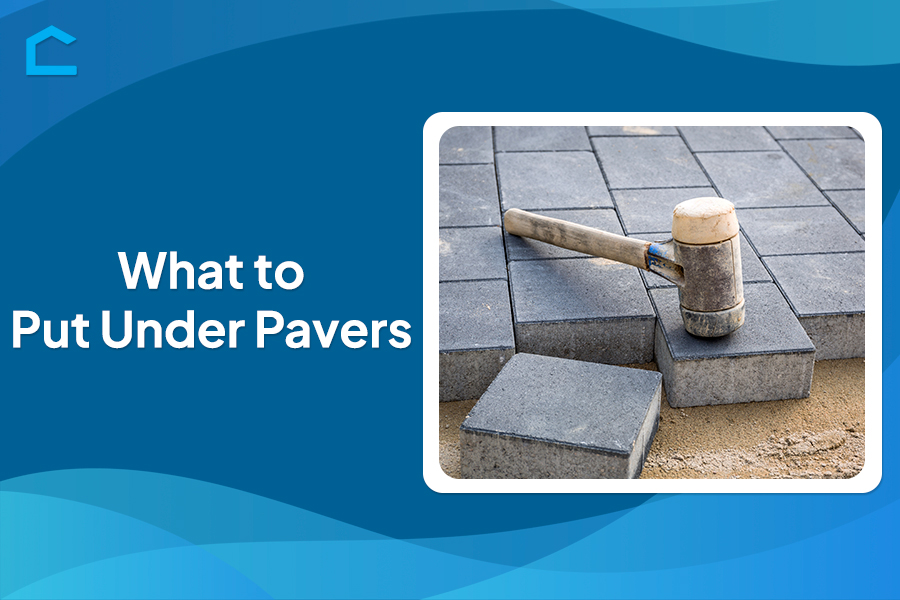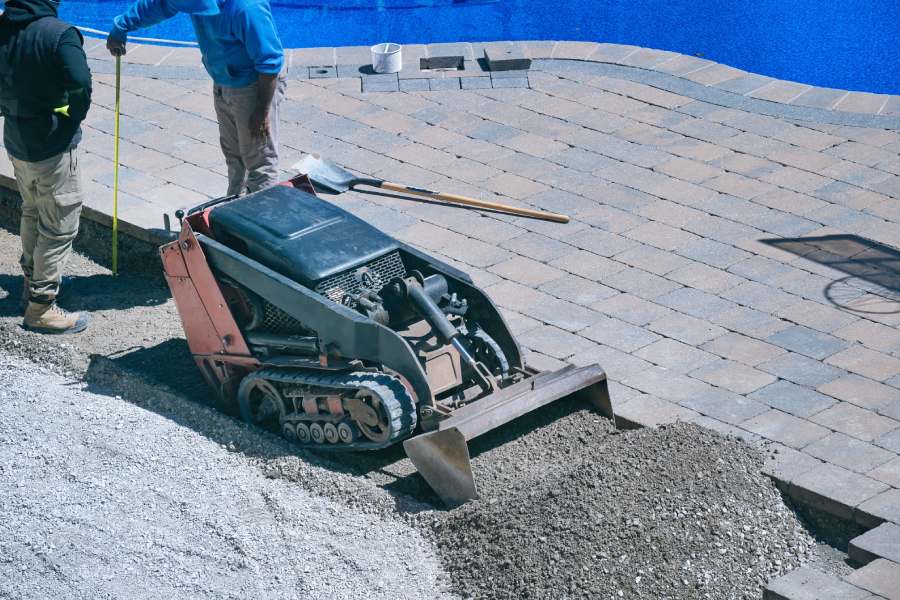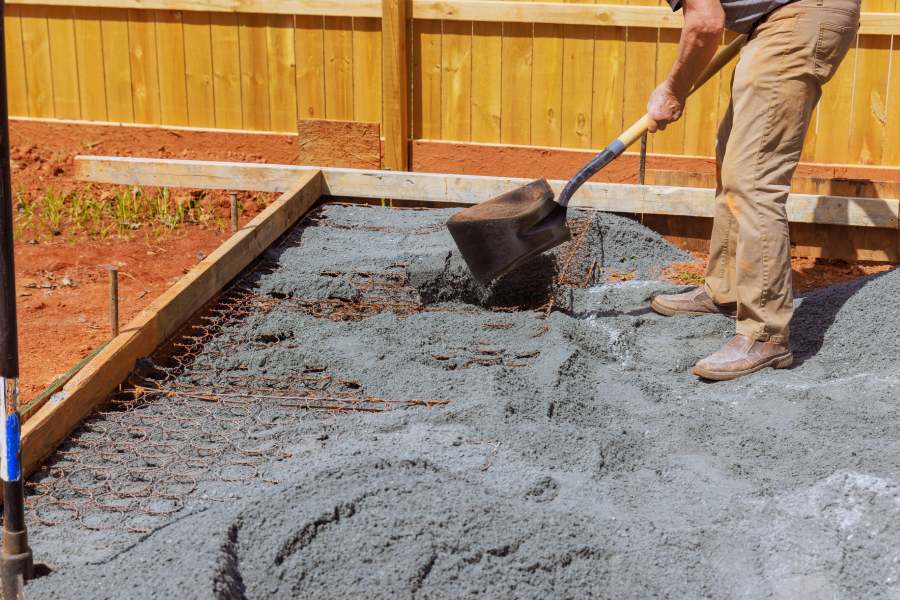What to Put Under Pavers?

Creating a stunning outdoor space that impresses guests and withstands the test of time requires careful consideration of what lies beneath your pavers. The foundation is just as crucial as the pavers, influencing stability, drainage, and longevity. But are you 100% sure what to put under pavers?
Without the right foundation, even the most expensive and meticulously installed pavers can shift, settle unevenly, or create tripping hazards. So, we will explore the essential components you need to consider when preparing for your paver installation.
With the right groundwork, you can transform your outdoor area into a stunning retreat that enhances your home’s curb appeal and provides lasting enjoyment. Let’s dive into the key elements to make your paver project successful!

What to Put Under Pavers
To create a stable foundation for pavers, it is essential to layer three specific materials in the correct order, from bottom to top: geotextile fabric, a crushed stone or gravel base, and bedding sand. The materials used beneath the pavers are crucial to the overall success of the installation. They not only prevent settling and drainage issues but also extend the lifespan of your hardscape.
Professional contractors adhere to industry-standard guidelines when constructing these foundational layers, which have been proven effective across various climates and soil conditions. Each layer plays a distinct role in ensuring stability and durability. We will take a closer look at each layer and its unique purpose.
Base layer: Crushed stone or gravel
Crushed stone or gravel serves as the crucial foundation for any paver installation. It comprises angular rocks ranging from 3/4 inch down to fine particles. Often referred to as “crusher run” or “road base,” this material offers exceptional stability due to its interlocking nature.
The required depth of the base varies depending on the project type: walkways typically require a depth of 4 to 6 inches, while driveways demand 8 to 12 inches. Crushed stone’s angular shape generates more surface friction than rounded gravel, making it a superior choice for base preparation.
When compacted in layers, this base material can achieve a compaction rate of up to 95%, effectively preventing future settling. The spaces between the stones also create essential drainage pathways that help prevent water pooling.
Bedding layer: Sand
The bedding layer is composed of concrete sand spread approximately 1 inch thick over the compacted base material. This layer serves as a setting bed for the pavers and must be meticulously leveled using specialized screeds. The uniform texture of the sand allows for precise height adjustments during the pavers’ placement.
The consistency of this sand layer is crucial, as any irregularities will be reflected in the final surface. The sand particles fill small voids between the pavers and the base material, providing additional stability. Once the pavers are installed, polymeric sand is typically swept into the joints to lock everything securely together.
Geotextile fabric
A layer of geotextile fabric, commonly referred to as landscape fabric, plays a vital role as a barrier between the soil and the base material. This permeable material allows water to flow through while preventing the mixing of soil and stone layers over time. Also, the fabric serves as a deterrent against weed growth, minimizing long-term maintenance efforts.
When installing the fabric, you must be careful to avoid wrinkles and gaps that could undermine its effectiveness. The edges should overlap at least 6 inches to ensure a continuous barrier beneath the paved area.
So, investing in high-quality fabric is important. It will maintain its integrity for many years, even when subjected to the weight of the pavers and base materials.
Compacting the base and bedding layers
Proper compaction of the base layer requires multiple passes with a plate compactor, working in 2-inch lifts or layers. Each layer must be thoroughly wetted and compacted before adding the next, ensuring uniform density throughout the base.
This systematic process prevents air pockets and weak spots that could lead to future settling. The bedding sand also requires careful compaction, though less intensive than the base layer.
After screeding the sand perfectly level, light compaction helps settle the material without creating depressions. Special attention must be paid to maintaining consistent moisture content during compaction, as overly wet or dry materials won’t achieve proper density.
How to Prepare for Paving
Site assessment and planning
Before you begin any digging, you should contact utility companies to have underground lines and pipes marked. Once that’s done, create a detailed layout plan that considers drainage patterns while marking your project boundaries with stakes and string lines. Be sure to take accurate measurements and add an additional 6 to 12 inches on each side to accommodate edge restraints.
Next, consider your area’s climate and ensure you obtain any necessary local permits before commencing work. Establishing a proper slope of about 1 inch for every 8 feet away from buildings is essential for effective drainage. This slight grade helps prevent water from pooling, reducing the risk of damage to the pavers and nearby structures.
Ground preparation
To prepare the area, begin by removing all vegetation, topsoil, and debris. Compact the existing soil with a plate compactor to establish a firm foundation. If you encounter any soft spots or organic material, replace them with compacted gravel to prevent future settling.
Then, test the soil’s composition and drainage capabilities by conducting a percolation test. Dig a 12-inch hole, fill it with water, and observe the drainage rate. Additional preparation may be necessary if the soil has poor drainage, such as clay. This can include installing a drainage system or mixing in crushed stone to enhance water flow.

How Deep to Dig for Pavers
Total excavation depth
When preparing for your excavation, you need to consider the standard depth requirements. Typically, this depth consists of your pavers’ thickness, the base materials, and an additional inch of bedding sand.
For a typical residential patio using 2.375-inch pavers, you’ll need to dig approximately 7 to 9 inches deep. This includes 4 to 6 inches for the base material, 1 inch for sand, and 2.375 inches for the pavers.
To ensure even settling, maintaining a consistent depth throughout the excavation area is crucial. You can achieve this by using a laser level or a string line to check for uniformity in depth.
Also, you should create a slight slope away from buildings, ideally 1 inch for every 8 feet, to facilitate proper drainage. By incorporating this slope, you can ensure that your calculated depth requirements are met while preventing water from pooling around structures.
Base requirements by usage
When constructing driveways, a deeper excavation is essential, typically requiring a total depth of 10 to 12 inches to accommodate the weight of vehicles. In contrast, walkways and patios generally necessitate less base material, with a total depth of around 6 to 8 inches being sufficient. However, in regions that experience freeze-thaw cycles or have poor soil conditions, you need to increase these depths by 2 to 3 inches to enhance stability.
It’s also important to adjust your base depth according to the type of soil present. For sandy soils, a depth of about 4 to 6 inches is typically adequate, whereas clay soils necessitate deeper bases of 6 to 8 inches to ensure proper support and drainage.
You must gradually adjust the base depth over several feet when transitioning between different paved areas, such as where a walkway meets a driveway. This approach helps prevent abrupt changes that could lead to settling issues over time.
Conclusion
The success of your paver installation hinges on the foundation you create beneath the surface. Knowing what to put under pavers—geotextile fabric, crushed stone or gravel, and bedding sand—ensures stability, proper drainage, and longevity for your outdoor spaces. Each layer plays a vital role, from providing a solid base to preventing soil and stone mixing, ultimately safeguarding against settling and erosion.
As you embark on your paver project, remember that thorough planning, proper excavation, and attention to detail are essential. When it comes to creating the perfect outdoor space, the importance of a solid foundation cannot be overstated.
Homeowners face the challenge of ensuring that the contractors they hire are skilled and reputable. This is where Services Curated excels. We empower you to make informed choices, connecting you with the most reliable professionals in every category. We aspire to instill trust and confidence, ensuring rigorous verification processes back our recommendations!
